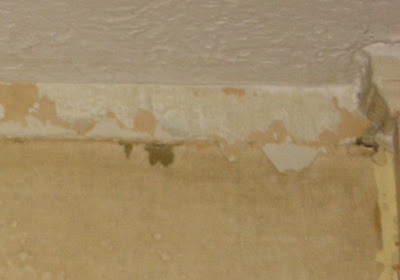
Defects at this corner in a high-traffic hallway were particularly daunting to the homeowner, leading to a call for help after attempted painting prep with removal of kitchen wallpaper. Enamel finish is poorly bonded. A horizontal crack is bulged out. A vertical crack 1 1/2" from the corner is unstable. Old repairs with paper tape and mud have come undone.

Here the corner is ready for grouting. No cracks are large enough to permit repair with plaster. If the only tools in the box were brittle setting mud and Fix-It-All, one would choose Fix-It-All. "Durabond" is sometimes recommended, but that is just a brand name for setting mud. A flexible and adhesive patch material will survive corner impact: my flexible grout.
All filling was done in about three troweled applications of flexible grout. The final result met the goals of prep: nothing to be seen, and confidence in durability.
The adjacent enamel paint edges are sandably stabilized by the flexible grout. The enamel adhesion is poor, but I had to stop peeling somewhere. This will hold. Where adjacent paint is latex and also not well bonded, the flexible grout is even more useful. Water in mud tends to aggravate the paint release; not so flexible grout with its acrylic base.








 Cured flexible grout along the groove of a plastic container lid tolerates severe bending. I have not found any other simple-to-use patch material that passes this test of adhesion and flexibility.
Cured flexible grout along the groove of a plastic container lid tolerates severe bending. I have not found any other simple-to-use patch material that passes this test of adhesion and flexibility.
 This quantity of plaster is just sufficient for a first base coat over all open lath on this wall. I tilt the tub, and add water by pouring, to start.
This quantity of plaster is just sufficient for a first base coat over all open lath on this wall. I tilt the tub, and add water by pouring, to start.


